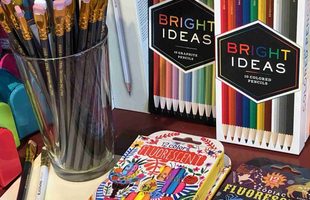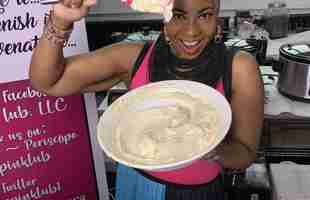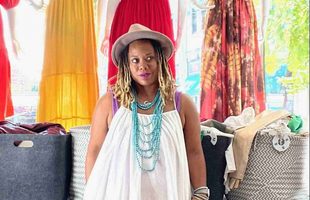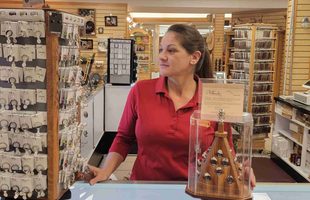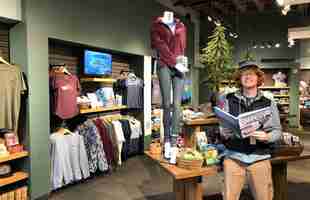By Karen Appold
When an item sells well at a museum shop, it makes sense to focus your efforts on selling more of that item. For Chacho Herman, associate director of earned income, San Diego Museum of Art, San Diego, Calif., the best-selling merchandise items are Buddha boards, Esslip pleated necklaces from Greece and postcards. “All of these items sell well because they inspire curiosity and creativity, and they’re unusual,” he said. Additionally the price points are reasonable. The first two items are between $35 and $40, and are an easy pickup for shoppers wanting gifts or something for themselves. Postcards are $1 each.
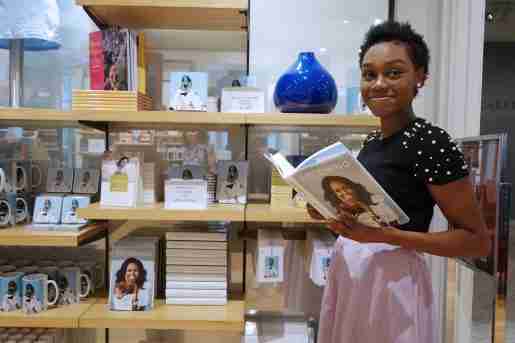 Alicia Grace, sales associate, Smithsonian American Art Museum and National Portrait Gallery. The 2019 100th anniversary of the 19th amendment has generated new products for the store. Photo by Bradley W. Johnson.
Alicia Grace, sales associate, Smithsonian American Art Museum and National Portrait Gallery. The 2019 100th anniversary of the 19th amendment has generated new products for the store. Photo by Bradley W. Johnson.The Buddha boards are like an ink and brush set, but instead of dealing with the mess of actual ink it uses water. As the water dries, the painted image disappears, creating a Zen-like experience, Herman explained. The Esslip necklaces are colorful and eye catching, and create beautiful shapes when worn. Everyone wants a postcard, a great keepsake.
Lori Petrelius, visitor engagement and store manager, KidsQuest Children’s Museum, Bellevue, Wash., said low-priced impulse items are always a top seller, especially Toysmith’s Flip Cars, Crazy Aaron’s Thinking Putty and Loot Toy’s Bath Squigglers. “These small items are great souvenirs,” she said. “These companies are easy to order from and have low order minimums, which is helpful because we have a small store (only about 100 square feet) and even smaller storage space.”
The shop has also had great success selling healthy snack options. “We don’t have a cafeteria or vending machines, so parents appreciate having quick and easy snacks, such as applesauce pouches and string cheese, readily available,” Petrelius said. “And we haven’t forgotten about the adults; canned, cold brew coffee is one of our most popular drinks.”
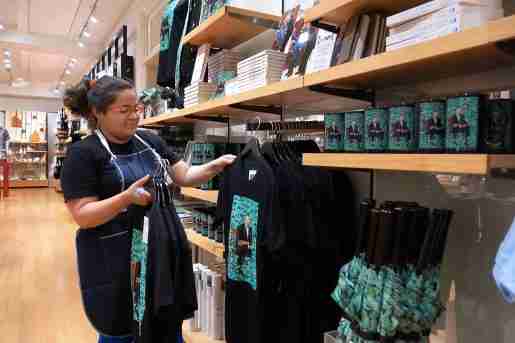 Smithsonian American Art Museum and National Portrait Gallery Receiving Lead Giovanna Ramos. The store replenishes top-performing product constantly. Photo by Bradley W. Johnson.
Smithsonian American Art Museum and National Portrait Gallery Receiving Lead Giovanna Ramos. The store replenishes top-performing product constantly. Photo by Bradley W. Johnson.Wendy Brown, store director, Smithsonian American Art Museum and the National Portrait Gallery, Washington, DC, reported that the Barack and Michelle Obama portrait product has been in high demand. The paintings were first exhibited at the National Portrait Gallery on February 12, 2018. “The unveiling led to thousands of visitors lined up at the entrance, along with a 311 percent increase in visitors compared with the prior President’s Day weekend,” she said. The Obamas made history by commissioning the first African-American artists, Kehinde Wiley and Amy Sherald, to paint official portraits for the president and first lady. Other current top-selling items for Brown relate to women’s empowerment. This year is the 100th anniversary of the 19th amendment which gave women the right to vote. “The Smithsonian launched a joint effort called ‘Herstory’ to commemorate the event,” Brown said. “We created custom product to support the theme.”
For Lori Hoepfinger, guest relations museum store coordinator, Museum of Arts & Sciences, Daytona Beach, Fla., kids’ items typically sell best. “As a children’s museum and planetarium, we get a lot of families,” she said. “I try to stock educational toys such as experiment kits, night sky guides and puzzles. Kids also like nature items such as field guides, binoculars and nature activity books. Jewelry, inspired by permanent collections, is also a hit.”
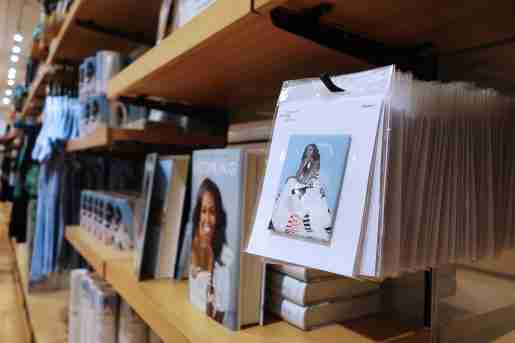 Michelle Obama merchandise at the Smithsonian American Art Museum and National Portrait Gallery. Portrait products for Michelle and Barack Obama has been in high demand at the store. Photo by Bradley W. Johnson.
Michelle Obama merchandise at the Smithsonian American Art Museum and National Portrait Gallery. Portrait products for Michelle and Barack Obama has been in high demand at the store. Photo by Bradley W. Johnson.Capture Customers’ Eyes
There are many ways to boost merchandise sales, beginning with how they are displayed. Herman aims to keep shoppers’ eyes off balance. “Using color and texture to attract and then using an asymmetrical display to keep the customer engaged helps sell an item,” he said. “Repetition in product displays works well, too. Advertisers believe that customers need to hear a message multiple times before they will buy anything; it works the same way with retail displays.”
With such a small space, Petrelius has to be creative with displays. “Moving things around seems to be the best strategy,” she said. “I try to switch out the most visible spaces weekly, so that every time guests walk through our front doors they see something new at the entrance.”
Put Your Best Food Forward
Staff members who offer great customer service get results. “Create an atmosphere of comfort and trust; be conversational and ask open-ended questions,” Herman said. “Also, it’s not just about selling an item. It’s about telling the story behind it. For example, a piece of jewelry made by a local artisan may have been inspired by a work of art within the museum. It’s fun to tell that story and interesting for customers to hear it. You can talk about when you visited that jeweler at her studio, and how you discussed the work of art and worked through design ideas. I did this to develop a line of jewelry for our current exhibition, ‘Art & Empire: The Golden Age of Spain.’ The pieces I worked on with that jeweler are hot sellers.”
Personal customer service can have tremendous results, too. Herman recalled delivering a large Chinese chest in his car to a customer’s home to see if it would fit the spot she had envisioned for it. Although the chest didn’t fit the spot, the lady has been a frequent customer and high-level donor to the museum.
For the last fiscal year, Herman reported flat attendance—which is related to the popularity and subject matter of exhibitions. “It’s also impacted by tourism and the city’s investment in promoting San Diego and Balboa Park (where the museum is located) to the national and international market,” he said. “Advertising and public relations as well as programming and special events also impact gallery attendance.” The museum’s main store is 1,100 square feet and its satellite shop is 280 square feet.
Having a knowledgeable team that is well versed in the museum’s exhibits, programs and events and how products relate to the former contributes to the shop’s success in selling more items, Brown said. “Staff share ideas and product knowledge among each other,” she said. “We point out new products as they arrive and ensure that floor moves are communicated so all team members are aware of each product, its origin and location within the store.”
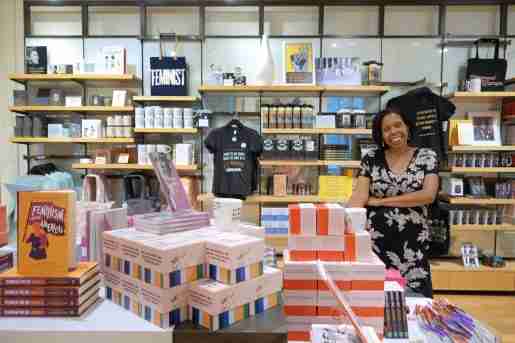 Store Director Wendy Brown of the Smithsonian American Art Museum and National Portrait Gallery in Washington, D.C. Women’s empowerment merchandise sells well for the store. Photo by Bradley W. Johnson.
Store Director Wendy Brown of the Smithsonian American Art Museum and National Portrait Gallery in Washington, D.C. Women’s empowerment merchandise sells well for the store. Photo by Bradley W. Johnson.When choosing staff volunteers to work in the store, Hoepfinger tries to select people with a bit of retail experience or those with an outgoing personality. “We ask them to greet each guest who walks in and briefly engage them in conversation,” she said. For example, they could ask if this is their first time visiting the museum or if they’re from the area. “That can bring up a lot of information. Sometimes they will talk about a favorite exhibit and the volunteer can show them merchandise pertaining to it.”
Other Top Sales Tactics
Petrelius reported a spike in sales of products that customers can try out. “They are more likely to see how great it is,” she said. “I work closely with our educational team to see how we can use our products on the floor and in our programming. I can look through our sales and tell what day our education team used Wise Elk’s mini bricks for a program, for example, because there will suddenly be several sold.” The shop garners $70,000 annually.
If a product is not performing, Brown said it is re-merchandised and given a new home in the shop. Top-performing product is constantly replenished and placed in prime selling space.
Hoepfinger shares new items with store volunteers. “I like them to be familiar with merchandise, so they can appropriately suggest it to guests. We are also planning to start some new team sales goals. We might feature a particular item or have a daily sales goal, track it for a time period and come up with a group reward if the goal is reached.” The two museums on campus each have a store, which are 476 and 288 square feet. The stores are on track to break $50,000 in sales this year.
